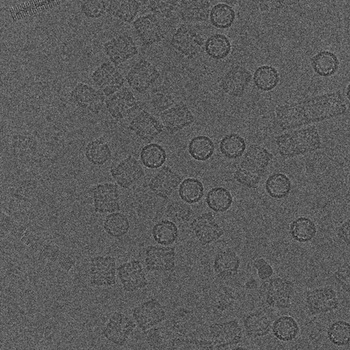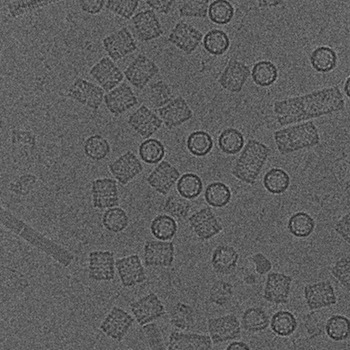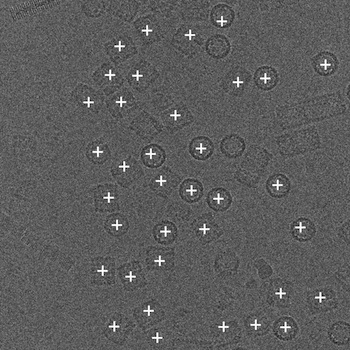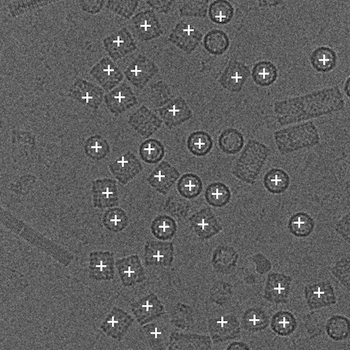Public Data Sets: KLH Dataset I¶
KLH Dataset I: 82 defocus pairs of micrographs, coordinate centers of ~1000 side-view particles, a preliminary 3D reconstruction.
NOTE: This is the standard dataset used in the particle selection "bakeoff" (JSB, vol. 145, pp. 3-14, 2004).
1. Images.¶
Images were acquired, using a Philips CM200 TEM equipped with a 2Kx2K CCD Tietz camera, as defocal pairs at a nominal magnification of 66,000x and a voltage of 120 KeV, using the Leginon system (Potter et al., 1999 ; Carragher et al., 2000). The first image (named *.001.mrc) is acquired at near to focus (NTF) conditions (~ -1µm) and the second image (named *.002.mrc) at farther from focus (FFF) conditions (~ -3µm). The time interval between the two exposures is approximately 20s due to camera readout time. Pixel size is 2.2Å at the specimen and the accumulated dose for each high magnification image area was ~10 e/Ų.
Below is an example of a defocus pair. Click on the images to see at full scale.
(a)  (b)
(b) 
(a) Near to focus - NTF image. (b) Far from focus - FFF image.
Figure 1: An example pair of high magnification images of KLH.
Downloading High Magnification Images¶
Image files are provided in MRC format and as JPEG files. Use one of the following options to download the images.
- Download only far-from-focus (FFF) images: MRC files (384MB), JPEG files (94MB).
- Download only near-to-focus (NTF) images: MRC files (383MB), JPEG files (94MB).
We suggest using a tool called em2em, to convert MRC files to other formats.
2. Positions of the Picked Particles in the Images¶
Particles are picked in the FFF images and these coordinates can be used to select particle in the NTF images. Particle form the NTF images were used in the recontruction. Phase correlation was used to align the two images to calculate the offset between the FFF coordinates and the NTF coordinates. We provide two sets of picks: (2.1) manual and (2.2) Selexon (Zhu et al., 2001).
(a)  (b)
(b) 
(a) The NTF image. (b) The FFF image.
Figure 2: An example pair of images outlined with particles automatically picked by Selexon. Each "+" indicate a detected particle.
2.1 Manual Picking:¶
The KLH didecamer presents in two main orientations, a rectangular sideview and a circular topview. Intermediate views, broken molecules and aggregates are also visible. From the 82 images, 1042 single particles were manually identified. Rectangular sideviews and intermediate orientations were selected with a percentage of ~95 % and ~5 %, respectively. No circular topviews were selected.
Coordinates of particles in the FFF images.
2.2 Automated Picking:¶
An edge-based computational approach was used for automatic particle detection. The Canny edge detector (Canny, 1986) is applied to the images, followed by a sequence of ordered hough transforms (HTs) to detect particle contours in the edge images. The sequence of HTs is applied in order from the computationally simplest to the most complex. Edge elements that are covered by the detected shapes are removed immediately from edge images following the application of the last HT. Hence, the next HT is applied to the edge image becoming equivalent to one that had not contained the detected shapes. By doing so, not only can we taper the effect of noisy edge elements on subsequent HTs, but also reduce significantly the total computational complexity. In the case of picking KLH particles, a sequence of two types of HTs was necessary. First, circular particles were detected using the fast implementation of the Hough transform for the detection of circles , and edges covered by those detected circular regions were removed; then rectangular Hough transform were used to extract approximately rectangle-shaped particles (Zhu et al., 2003).
Coordinates of particles in the FFF images.
3. Sample 3D Reconstructions and a Preliminary 3D Map¶
Sample 3D reconstructions generated using particles selected either manually or automatically.
| Picker | Three-dimensional Density Map | Description of Reconstruction Procedures | Comments |
| Fabrice Mouche |   |
A D5 point-group symmetry was imposed. The series of 1042 particles was subjected to three cycles of 3D projection alignment, using a previous volume as a reference, and a new reconstruction volume was calculated. | Coordinates of particles went into the map. |
| Selexon |   |
A D5 point-group symmetry was imposed. The series of 1243 particles was subjected to three cycles of 3D projection alignment, using a previous volume as a reference, and a new reconstruction volume was calculated. | None. |
Note: A preliminary 3-D map of the particle is also available in two different formats: MRC format and SPIDER format. (The size of the map files are about 46 MB after being gzip'ed).
Updated by Eric Hou over 13 years ago · 52 revisions